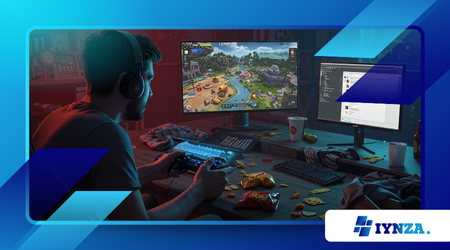The Psychology Behind Why We Get Addicted to Certain Games

Have you ever told yourself “just one more match” only to realize hours have passed? That pull isn’t random—it’s by design.
Anúncios
The psychology behind why we get addicted to certain games is rooted in how our brains respond to reward, progression, and challenge. Developers understand how to tap into these systems and craft experiences that feel irresistible.
Whether it’s the thrill of a clutch win or the satisfaction of leveling up, games feed our need for achievement and autonomy. And the most addictive ones know exactly how to keep that loop going.
But what makes some games so much harder to put down than others? It’s not just good graphics or fast gameplay—it’s psychological design.
The Dopamine Loop That Keeps You Hooked
Every time you achieve something in a game—win a round, unlock a skin, complete a quest—your brain releases dopamine, the “feel good” chemical. Games structure these hits to be spaced just right: not too often to become boring, but not too rarely to feel pointless.
This reward system mimics the mechanics of slot machines, training players to associate unpredictable rewards with extended play.
That’s why randomized loot boxes, rare drops, and ranking systems are so effective at keeping players engaged. They’re not just fun—they’re neurologically stimulating.
Add to this the concept of “near wins,” where you almost achieve something, and the brain gets even more involved. You stay invested because you almost had it. And the next round? That could be the one.
Read also: Gaming Addiction: How to Find a Healthy Balance
Progression Systems and the Illusion of Control
Leveling up. Unlocking gear. Completing achievements. These aren’t just features—they’re psychological hooks. Progression systems create a sense of forward momentum, giving players the illusion that effort always leads to improvement.
But it’s more than that. Games often offer micro-goals that can be completed in short bursts, making it easy to justify continued play. “Just one more mission” becomes a loop of tasks designed to feel endlessly rewarding.
This structure also reinforces control. You choose what to do, when to do it, and how to progress. That freedom feels empowering—and the more you play, the more invested you become in your personalized path.
Social Pressure and Competitive Motivation
Multiplayer games bring another layer to the addiction cycle: social identity. Whether it’s keeping up with friends, chasing a leaderboard spot, or avoiding letting teammates down, social motivation fuels sustained engagement.
You’re not just playing for yourself—you’re playing for your place in a community. Competitive games, especially ranked ones, amplify this pressure.
The stakes feel personal. Wins bring validation, losses feel like failure. And when your in-game rank reflects your perceived skill, it becomes hard not to attach part of your self-worth to it.
Even games that seem casual on the surface—like mobile titles—often include social features that subtly push you to keep up with others. It’s not just addiction. It’s identity reinforcement.
The Power of Immersion and Escapism
Some games don’t hook you with rewards or rankings—they absorb you through storytelling, atmosphere, and emotional immersion. In these cases, the psychological draw comes from escapism.
You enter a world where you have purpose, agency, and sometimes even a second life. That feeling of being “in the zone” or losing track of time isn’t just satisfying—it’s therapeutic. Games become safe spaces to disconnect from stress, pain, or monotony.
And that’s why narrative-rich RPGs or expansive open worlds can be just as addictive as fast-paced shooters. They offer emotional engagement and continuity. You’re not just playing—you’re living a story.
Variable Reinforcement: The Most Addictive Mechanic
One of the most potent psychological tactics in game design is variable reinforcement. It’s the principle that unpredictable rewards are more effective at driving behavior than consistent ones.
When you don’t know exactly when a reward will come—or how big it will be—you’re more likely to keep trying. Games like Genshin Impact, FIFA Ultimate Team, or CS:GO weapon cases use this to full effect.
It’s why people keep opening loot boxes despite low odds. It’s the same mechanism that fuels gambling addiction.
This system isn’t always malicious—but it does need to be recognized. Knowing how variable reinforcement works helps you become more aware of when the game is playing you.
How Emotional Anchors Amplify Gaming Addiction
Games often tie themselves to emotional experiences. That first epic win. The friends you made. The nostalgia of a soundtrack or art style. These emotional anchors create long-term loyalty—and sometimes obsession.
When a game becomes tied to your mood, your routine, or your relationships, it stops being just entertainment. It becomes an emotional staple. Quitting feels like losing a part of yourself, not just a pastime.
Developers use this emotional layering intentionally. Seasonal events, returning characters, memory callbacks—they all build a stronger emotional web that keeps players returning even when they’ve lost interest in the gameplay itself.
When Fun Turns Into Compulsion
There’s a point where gaming shifts from joy to compulsion. You’re no longer playing because it’s fun—you’re playing because you have to. Because stopping feels worse than continuing.
This happens when the psychological mechanisms overpower your agency. You feel obligated to log in for rewards, chase a rank that no longer brings satisfaction and feel anxious missing a day. That’s when the line between habit and addiction blurs.
Recognizing this shift is vital. Games should enhance your life, not control it. And when the cycle starts feeling more like pressure than pleasure, it’s time to reassess the relationship.
Healthy Ways to Enjoy Games Without Losing Balance
Understanding the psychology behind gaming addiction doesn’t mean you have to stop playing. It means you play with awareness. Set limits. Use games as enrichment, not escape. Turn off notifications when needed. Play with people who uplift, not pressure.
Take breaks without guilt. Reflect on what you’re getting from a game—joy, stress relief, social connection—and what you might be avoiding. If it ever stops being fun, you’re allowed to walk away.
Because at the end of the day, the best games respect your time—and so should you.
FAQ: Why we get addicted to certain games
1. Is gaming addiction the same as substance addiction?
Not exactly, but both activate similar reward systems in the brain and can lead to compulsive behavior.
2. Can casual games be addictive too?
Absolutely. Even simple mobile games use reward loops and social features that promote daily play.
3. What are signs that I’m addicted to a game?
Loss of control, playing despite negative effects, and emotional distress when not playing are red flags.
4. Do developers intentionally design games to be addictive?
Many do use psychological principles to increase engagement, though not all do so unethically.
5. How can I regain balance if I feel addicted?
Start by setting boundaries, taking short breaks, and seeking support from friends or professionals if needed.
